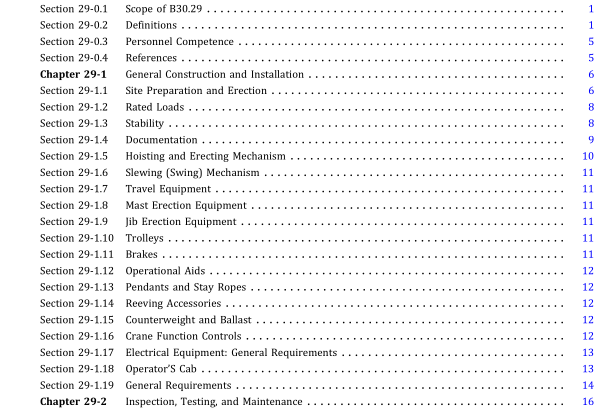ASME B30.29-2018 pdf free download.Self-Erecting Tower Cranes Safety Standard for Cableways, Cranes, Derricks, Hoists, Hooks, Jacks, and Slings
SECTION 29-1.2: RATED LOADS 29-1.2.1 Rated Loads Where Stability Governs Lifting Performance
(a) Foreach stipulated operatingradius, the rated load shall be in accordance with EN 14439, section 5-2.
(b) Wind force effect on stability shall be determined using the maximum in-service wind velocity, as specified by the manufacturer, applied in the direction least favor- able to stability.
(c) For cranes designed to travel with load, inertial forces and forces induced by the maximum allowable track variation from level, as specified by the manufac- turer, shall be considered in establishing rated loads.
(d) The following stipulations shall apply to the establishment of rated loads:
(1) The crane shall be mounted level as specified by the manufacturer, but for those cranes that exhibit signif icant elastic deformation due to dead, live, wind, or dynamicloads, the effectofsuch deformations on stability shall be taken into account.
(2) Lifting attachments that are a permanent part of the crane shall be considered part of the dead load for stability calculations.
(3) The manufacturershall specifyifoutriggers and/ orcounterweight/ballastarerequiredto achievestability. (4) For rail-mounted cranes, the track shall be level asspecifiedbythemanufacturer.Wherethemanufacturer information does not exist, the rail shall be level in accor- dance with EN 14439. See paras.
29-1.1.1(c) through 29- 1.1.1(h).
(e) The effectiveness of these preceding stability factors will be influenced by such additional factors as freelysuspended loads; track, wind, orground conditions; jib lengths; proper operating speeds for existing condi- tions; and, in general, careful and competent operation.
29-1.2.2 Rated Loads Where Structural Competence Governs Lifting Performance
(a) Foreach stipulated operatingradius, the rated load shall be in accordance with EN 14439, section 5-2. Dynamic effects associated with hoisting and slewing shall be considered.
(b) Wind shall be determined in the least favorable directionandatthemaximumin-servicevelocity,as specified by the manufacturer.
(c) For cranes designed to travel with load, inertial forces and forces induced by the maximum allowable track variation from level, as specified by the manufacturer, shall be considered in establishing structural competence.
(d) The following stipulations shall apply to the estab- lishment of rated loads: (1) The crane shall be mounted level, except as in para.
29-1.2.1(c), but for those cranes that exhibit signif- icant elastic deformation due to dead, live, wind, or dynamic loads, the effects of such deformations shall be taken into account.(2) Lifting attachments that are a permanent part of the crane inits workingconditionshall be considered part ofthedeadloadforratingcalculationpurposeswhetheror not such attachments are part of published rated loads.
29-
1.2.3 Rated Load Chart Durable rating charts with legible letters and figures shall be provided with each crane, one attached to the crane and one in the operator’s manual. The content of these charts shall include, but not be limited to, the following:
(a) a full and complete range ofcrane rated loads atall stated operating radii, jib lengths, hoist line reeving, and, where appropriate, for each available hoist line speed range and counterweight configuration.
(b) precautionary or warning notes relative to limita- tions on equipment and operating procedures.
(c) maximum permissible in-service wind velocity.
(d) notification that slings and lifting attachments are part of the load. If the lower load block is considered as part of the load, the rating chart shall so state.
(e) notification thatthe weight ofhoist ropes beyond a statedsuspendedlengthareto be takenas partofthe load.
(f) erection and dismantling clearances.
SECTION 29-1.3: STABILITY 29-1.3.1 Backward Stability An unloaded crane exposed to in-service wind forces in the unfavorable direction, and to an upward force at the trolley or jib tip equal to 30% of the rated load at any operating radius, shall not tip over backward. Additionally, the crane shall not tip over backward with 100% of the actual weight of the jib plus the fixed loadhandling attachments and the full unfavorable inervicewind.Outriggersorcounterweight/ballastshall be specified to achieve backward stability. ASME B30.29 pdf download.ASME B30.29-2018 pdf free download
